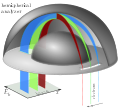Electron spectroscopy refers to a group formed by techniques based on the analysis of the energies of emitted electrons such as photoelectrons and Auger...
6 KB (782 words) - 13:00, 19 December 2024
Auger electron spectroscopy (AES; pronounced [oʒe] in French) is a common analytical technique used specifically in the study of surfaces and, more generally...
31 KB (4,117 words) - 04:12, 9 November 2024
Electron energy loss spectroscopy (EELS) is a form of electron microscopy in which a material is exposed to a beam of electrons with a known, narrow range...
22 KB (2,559 words) - 05:53, 7 April 2025
Electron paramagnetic resonance (EPR) or electron spin resonance (ESR) spectroscopy is a method for studying materials that have unpaired electrons. The...
52 KB (7,148 words) - 12:04, 25 May 2025
of any surface. It belongs to the family of photoemission spectroscopies in which electron population spectra are obtained by irradiating a material with...
43 KB (6,252 words) - 19:12, 19 May 2025
Electron phenomenological spectroscopy (EPS) is based on the correlations between integral optical characteristics and properties of substance as a single...
7 KB (787 words) - 09:42, 31 May 2025
Spectroscopy is the field of study that measures and interprets electromagnetic spectra. In narrower contexts, spectroscopy is the precise study of color...
44 KB (4,768 words) - 18:59, 23 May 2025
High resolution electron energy loss spectroscopy (HREELS) is a tool used in surface science. The inelastic scattering of electrons from surfaces is utilized...
19 KB (2,743 words) - 02:13, 8 August 2024
Photoemission spectroscopy (PES), also known as photoelectron spectroscopy, refers to energy measurement of electrons emitted from solids, gases or liquids...
10 KB (1,218 words) - 15:58, 9 May 2025
varieties of electron spectroscopy such as angle-resolved photoemission spectroscopy (ARPES), X-ray photoelectron spectroscopy (XPS) and Auger electron spectroscopy...
10 KB (1,486 words) - 05:50, 13 February 2025
across, i.e. too small for UV spectroscopy. Although electron spectroscopy has poorer energy resolution than light spectroscopy, data on properties in visible...
23 KB (3,018 words) - 22:36, 23 May 2025
to impact a target material, and X-ray spectroscopy — identification of the photons scattered from the electron beam impact, with the energy/wavelength...
28 KB (3,469 words) - 04:18, 28 May 2025
An electron spectrometer is a device used to perform different forms of electron spectroscopy and electron microscopy. This requires analyzing the energy...
4 KB (486 words) - 13:29, 31 August 2024
circuits. If an electron is excited into a higher state it leaves a hole in its old state. This meaning is used in Auger electron spectroscopy (and other x-ray...
18 KB (2,315 words) - 16:37, 18 May 2025
photoemission spectroscopy (ARPES) is an experimental technique used in condensed matter physics to probe the allowed energies and momenta of the electrons in a...
47 KB (6,046 words) - 07:25, 16 July 2024
Spectrometer (section Electron spectroscopy)
Likewise, unpaired electrons interact with magnetic fields, yielding the technique of electron paramagnetic resonance. Some forms of spectroscopy involve analysis...
16 KB (1,072 words) - 11:42, 13 March 2025
as Auger electron spectroscopy (AES). X-ray photoelectron spectroscopy (XPS) is another close relative of EDS, utilizing ejected electrons in a manner...
12 KB (1,632 words) - 21:47, 7 May 2025
Wavelength-dispersive X-ray spectroscopy (WDXS or WDS) is a non-destructive analysis technique used to obtain elemental information about a range of materials...
6 KB (698 words) - 18:46, 20 April 2025
energies were for electrons emitted from metals and other solid surfaces. In about 1956, Kai Siegbahn developed X-ray photoelectron spectroscopy (XPS) for surface...
9 KB (922 words) - 15:18, 22 May 2025
low-energy electron microscopy (LEEM). In biology, it is called photoelectron microscopy (PEM), which fits with photoelectron spectroscopy (PES), transmission...
20 KB (2,699 words) - 01:24, 26 May 2025
control and analysis. Reflection high energy electron diffraction - total reflection angle X-ray spectroscopy is a technique for monitoring the chemical...
26 KB (3,213 words) - 18:38, 26 June 2024
Mössbauer spectroscopy is a spectroscopic technique based on the Mössbauer effect. This effect, discovered by Rudolf Mössbauer (sometimes written "Moessbauer"...
34 KB (3,710 words) - 10:39, 7 March 2025
spectroscopy χ – see magnetic susceptibility AAS – Atomic absorption spectroscopy AED – Auger electron diffraction AES – Auger electron spectroscopy AFM...
15 KB (1,398 words) - 20:21, 9 November 2024
Infrared spectroscopy (IR spectroscopy or vibrational spectroscopy) is the measurement of the interaction of infrared radiation with matter by absorption...
53 KB (5,943 words) - 18:48, 22 May 2025
Time-resolved two-photon photoelectron (2PPE) spectroscopy is a time-resolved spectroscopy technique which is used to study electronic structure and electronic...
5 KB (555 words) - 21:50, 23 May 2025
Field electron emission, also known as field-induced electron emission, field emission (FE) and electron field emission, is the emission of electrons from...
124 KB (15,721 words) - 17:55, 24 May 2025
measured or decomposed along a continuous variable, such as energy in electron spectroscopy or mass-to-charge ratio in mass spectrometry. Spectrum is also used...
22 KB (2,734 words) - 20:30, 23 May 2025
photoelectron photoion coincidence spectroscopy, TPEPICO, has two major advantages. Firstly, no kinetic energy electrons are produced in energy ranges with...
27 KB (3,011 words) - 14:11, 11 March 2024
photoemission spectroscopy. The energy of photons ( h ν {\displaystyle h\nu } , where h {\displaystyle h} is the Planck constant) emitted when electrons incident...
5 KB (687 words) - 18:49, 27 May 2025
tunneling spectroscopy (STS), an extension of scanning tunneling microscopy (STM), is used to provide information about the density of electrons in a sample...
26 KB (3,643 words) - 14:31, 24 May 2025
















